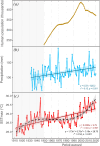Emerging skeletal growth responses of Siderastrea siderea corals to multidecadal anthropogenic impacts in Martinique, Caribbean Sea
- PMID: 40604069
- PMCID: PMC12222656
- DOI: 10.1038/s41598-025-08709-5
Emerging skeletal growth responses of Siderastrea siderea corals to multidecadal anthropogenic impacts in Martinique, Caribbean Sea
Abstract
Anthropogenic stressors on Caribbean reefs have shifted coral dominance toward stress-tolerant species such as Siderastrea siderea, increasing their importance for reef construction. However, the sublethal responses of these corals to past stressors remain understudied, limiting our understanding of their long-term acclimatization capacity. Here, we reconstructed the annual skeletal growth rates (1912-2020) of twelve S. siderea coral colonies from Martinique (Caribbean Sea) and examined their relationships with changes in human population, sea surface temperature (SST), precipitation, river discharge, and agricultural indicators between 1950 and 2020. Long-term growth rate declines observed since the 1950s were initially associated with human population, a proxy for local stress. Warming SST enhanced coral skeletal growth between 1950 and 1985, suggesting optimal temperatures for calcification during this interval. However, skeletal density exhibited a multidecadal (1950-2020) parabolic response, indicating a surpassing of this thermal optimum in recent decades. This parabolic response included persistent skeletal density declines from 2010 to 2020, possibly related to cumulative thermal stress or the interaction with ocean acidification effects. Our findings suggest a limited acclimatization capacity of long-lived S. siderea corals to cumulative pressures in Martinique and highlight their vulnerability to the compounding effects of local stressors and climate change.
Keywords: Caribbean sea; Climate change; Coral reefs; Local stressors; Sclerochronology; Sublethal effects.
© 2025. The Author(s).
Conflict of interest statement
Declarations. Competing interests: The authors declare no competing interests.
Figures





Similar articles
-
Reconstruction of long-term sublethal effects of warming on a temperate coral in a climate change hotspot.J Anim Ecol. 2025 Jan;94(1):125-138. doi: 10.1111/1365-2656.14225. Epub 2024 Nov 19. J Anim Ecol. 2025. PMID: 39562430 Free PMC article.
-
No-take area status is not sufficient to protect the population of a reef-building coral in Barbados.Mar Environ Res. 2025 Sep;210:107336. doi: 10.1016/j.marenvres.2025.107336. Epub 2025 Jun 28. Mar Environ Res. 2025. PMID: 40609247
-
The interactive impacts of a constant reef stressor, ultraviolet radiation, with environmental stressors on coral physiology.Sci Total Environ. 2024 Jan 10;907:168066. doi: 10.1016/j.scitotenv.2023.168066. Epub 2023 Oct 26. Sci Total Environ. 2024. PMID: 37890630
-
The reef-building coral Siderastrea siderea exhibits parabolic responses to ocean acidification and warming.Proc Biol Sci. 2014 Dec 22;281(1797):20141856. doi: 10.1098/rspb.2014.1856. Proc Biol Sci. 2014. PMID: 25377455 Free PMC article.
-
Water quality thresholds for coastal contaminant impacts on corals: A systematic review and meta-analysis.Sci Total Environ. 2021 Nov 10;794:148632. doi: 10.1016/j.scitotenv.2021.148632. Epub 2021 Jun 23. Sci Total Environ. 2021. PMID: 34323749
References
-
- Hughes, T. P. et al. Coral reefs in the anthropocene. Nature546, 82–90 (2017). - PubMed
-
- Woodhead, A. J. et al. Coral reef ecosystem services in the anthropocene. Funct. Ecol.33, 1023–1034 (2019).
-
- Perry, C. T. Alvarez-Filip, L. Changing geo‐ecological functions of coral reefs in the anthropocene. Funct. Ecol.33, 976–988 (2018).
-
- Donovan, M. K. et al. Local conditions magnify coral loss after marine heatwaves. Science372, 977–980 (2021). - PubMed
MeSH terms
LinkOut - more resources
Full Text Sources
Miscellaneous

